Pteris Ensiformis ‘Evergemiensis’ (Silver Lace Fern)
Original price was: ₹980.00.₹399.00Current price is: ₹399.00.
1 in stock
Size: Single Plant | Pot Included
SILVER LACE FERN OVERVIEW

Pteris ensiformis is an attractive perennial fern species in the Pteridaceae family. It originates from eastern Asia. Commonly known by the name Silver Lace Fern, this species produces showy foliage coloured green and white. This species is hardy to around -15 degrees Celsius. It grows best in consistently moist soil, in full to partial sunlight and can provide brightness to shady spots. Typically growing to a maximum height of around 1m, it can spread up to 5m in width.
How do you care for a silver laced fern? In order to thrive, silver lace ferns require a peat-based soil with good drainage, bright dappled light, 60-75°F temperatures, and 70-80% humidity levels. Water three times per week and fertilize once per month during the growing season. Daily misting or a humidifier may be needed.
Caring for Silver Lace Fern: Basic Guidelines
| Condition | Recommendation |
|---|---|
| Ideal soil | Peat-based, well-draining soil |
| Watering requirements | 3 times per week, distilled water |
| Lighting needs | Bright, diffused |
| Ideal temperature | 60-75°F |
| Ideal humidity | 70-80% |
| Best location | Bathrooms |
| Growth habits | Upright, triangular |
| Fertilization type/schedule | Liquid fertilizer / once monthly |
| Signs of deficiency | Dry, discolored foliage |
| Pruning | Occasional pruning to control growth/shape |
| Flowering | No |
| Toxicity | Nontoxic |
Due to its modest size and triangular shape, this plant can be enjoyed in hanging baskets, terrariums, or regular pots.
However you display yours, learn how to make it thrive with our tips on repotting, pest control, disease prevention, and more.
Complete Care Guide for Silver Lace Fern
The Latin name for its genus Pteris originates from the Greek name for fern, which also means “feathery” referencing its delicate foliage.
This quaint characteristic as well as its undemanding care makes the silver lace fern a delightful plant for both novice and seasoned indoor gardeners.
Silver Lace Fern at a Glance
- Plant Type: Ornamental perennial
- Scientific Name: Pteris ensiformis ‘Evergemiensis’
- Average Height: 1.5 feet
- Average Width: 1.3 feet
- Growth Rate: Fast
- Produces Flowers: No
- Common Pests: Whiteflies, mealybugs
- Life Expectancy: Years with good care
- Difficulty of Care: Medium
What To Do When You First Get Your Silver Lace Fern
- Feel the condition of the soil. Silver lace ferns thrive best in moist soil, not bone dry or soggy, so check to see if the top inch or so of soil is dry and water if so, checking it drains well.
- Check for any signs of pests. Detecting an infestation early on can prevent the need for chemical treatments, so check the health of the fern fronds (leaves) and stems for signs of pests (see “Common Pests” below).
- Make sure home conditions are ideal. Place it in your kitchen or bathroom where the air gets suitably steamy. If you can’t provide the humid air it needs, consider investing in a humidifier.
Ideal Soil for Silver Lace Fern
This plant needs a fast-draining, peat-based soil medium.
Dan Jones of the plant community Terrarium Tribe recommends “organic mix soil containing sphagnum moss, bark, and coconut coir” as this makes up a “nutrient-rich potting soil that effectively retains moisture and drains well.”
Silver Lace Fern Water Requirements
It may need watering three times weekly during summer or less, depending on conditions.
To determine the right frequency, Better Homes & Gardens recommends:
“Sticking your finger into the soil about an inch deep. If it’s still damp, wait a couple more days – ferns don’t mind drying out in between watering.”
Silver Lace Fern Lighting Needs
Silver lace ferns need dappled sunlight to replicate their tropical habitat.
A shady spot of your home such as a north- or west-facing windowsill will prevent the delicate fronds being scorched in the afternoon sun.
LED grow lights are also recommended to cover lost sunlight during winter. My plants love these fully adjustable lights with auto-on/off function.
Ideal Temperature Range for Silver Lace Fern
Between 60-75°F (15-24°C) is ideal. Don’t let temperatures drop below 55°F (13°C) as the ferns quickly experience stunted growth in the cold.
For this reason, take care never to place them directly near drafts or AC fans.
Ideal Humidity Level for Silver Lace Fern
Between 70-80% is the perfect humidity range for silver lace ferns. Daily misting and using a humidifier will help maintain levels in cooler, dry homes.
Many owners also advocate keeping this plant in a terrarium (or terrarium table for that matter!) with a pebble and water base to let water gradually evaporate around the plant for a slow-release humidity boost.
Best Location for Silver Lace Fern
Bathrooms are a popular spot for silver lace ferns, within a few feet of the window since this caters to their humidity and indirect lighting needs.
Just ensure it’s in a spot that won’t get soaked as this will result in damaged fronds.
Silver Lace Fern Growth Habits
This plant has a triangular growth habit and will grow fairly tall and wide if left un-pruned. Their fast-growing spread makes them equally suited to pots or hanging baskets.
Fertilization Type & Schedule for Silver Lace Fern
Help maintain its lush green appearance by treating it to a monthly fertilizer from April-October.
Either a liquid or a slow-release granulated fertilizer works well – just take care to dilute liquid strength by half and refrain from fertilizing during winter when growth is dormant.
Signs of Nutrient Deficiency
Wilting, dry foliage, and brown or yellow areas can all be signs of a nutrient deficiency.
This discoloration and drooping can point to overwatered soil, low humidity, or incorrect lighting conditions, so maintaining this plant’s ideal environment is the key to good health.
Pruning Silver Lace Fern
Pruning during summer is best while the fern is actively growing.
Trim off discolored ferns and larger fern fronds to control growth and maintain its full shape using clean plant scissors.
Alternatively, you can gently pinch off fronds using your fingertips at the tender growth at the end of the stem, as close to the leaf nodes as possible.
Does Silver Lace Fern Produce Flowers?
Silver lace ferns do not produce flowers.
They belong to the Pteridaceae or “Brake” family plant group that produces new stem clusters from the reproduction of spores instead of seeds.
Is Silver Lace Fern Toxic?
These plants are nontoxic to children and pets, though ingestion can cause allergic reactions in babies and pets with sensitive skin according to GardeningBrain, so vigilance is advised to prevent health risks.
Silver Lace Fern Propagation
As silver lace ferns grow in fairly dense clumps, you may decide to propagate (create new plant babies from the parent plant).
The ideal way to do this is by dividing the crown root system into separate root balls for replanting.
1. Gently Remove the Plant From Its Pot & Break Off the Soil
Carefully slide the plant out of its pot and break off the old soil.
Once the main root structure is exposed, you may need to untangle the roots and stems to help you see where each root ball branches off.
2. Cut Off Sections From the Main Root, Each Containing One Stem & Frond
Identify the root ball sections where new, young fern shoots are growing around the larger parent plant root.
Cut these into 2-inch sections using a clean, sharp knife, ensuring that each new root cutting contains at least one stem and a frond (fern leaf).
3. Plant the New Divisions Into Ideal Soil Mix and Water Well
Fill each new pot with your ideal soil mix and carefully place each new section into the center of their pot.
The roots of silver lace ferns grow primarily on the soil surface, so make sure each root section is only half-submerged in the soil.
As they’ll be small and delicate, it can help to secure the roots into place with toothpicks.
4. Find an Ideal Location for Them and Water Each New Planting Well
Once planted, water each one well to kick-start their moist environment, and find a suitable location for them.
Allow about a month for the new shoots to start developing due to the shock of being re-homed.
Repotting Silver Lace Fern
As your silver lace fern grows, it will need repotting in fresh soil for optimal health and to give ever-expanding roots a larger home.
When To Repot Silver Lace Fern
Repotting is necessary once a year, ideally during spring as it will be more receptive to being re-homed during its natural growth period.
Signs That It’s Time To Repot
- Roots are congested within the pot and visible beneath drainage holes.
- Water drains slowly in the current soil mix.
- Slow or stunted growth.
How To Repot Silver Lace Fern
1. Clean & Prepare a New Pot 2 Inches Larger Than the Current One
Thoroughly wash your new pot and fill with your new soil mix.
It should be at least 2 inches larger than your current pot to accommodate the following year’s root expansion and encourage good drainage and nutrient intake.
2. Remove the Plant From Its Existing Pot & Check the Root Health
Slide your silver lace fern out of its current pot and remove the old soil.
With the roots exposed, take this opportunity to check their condition – healthy fern roots will be pale or light brown and feel firm, but spoiled roots will be dark and feel soft and slushy.
Trim off any diseased root areas with a sharp, sterile knife.
3. Plant Into the New Pot & Water Well, Checking the Drainage
With healthy roots remaining, plant your rejuvenated silver lace fern into the center of your new pot, taking care to leave the crown root half-submerged in the soil.
Water immediately, and check that the water drains well.
Silver Lace Fern Common Problems & Solutions That Work
| Problem | Solution |
|---|---|
| Whiteflies | Warm, soapy water or neem oil |
| Mealybugs | Spray with insecticide or organic alternative |
| Botrytis | Organic fungicide |
| Nutrient deficiency | Prune affected foliage and repot |
| Browning fronds | Reduce fertilization, repot |
| Wilting fronds | Check for and remove damaged roots, let soil dry between waterings |
Silver Lace Fern Common Pests
If left unchecked, pesky critters can cause trouble for your silver lace fern. Here’s how you can spot (and deal with) common culprits:
Whiteflies
- Signs of Trouble – Small white-winged flies and sticky honeydew on foliage undersides.
- Solution – Spray the flies with a solution of warm soapy water or neem oil (an organic solution that acts as an insecticide).
- Prevention – Ensure humidity is not too high, hang sticky fly traps near the plant.
Mealybugs
- Signs of Trouble – White furry cotton-wool-like lice on leaf undersides.
- Solution – Spray them off with water, kill with insecticide (this one really works) or organic alternative.
- Prevention – As they’re easy to spot, remove them by hand, and review environmental conditions to avoid attracting them.
Silver Lace Fern Common Diseases
Poor care can risk the development of fungal infections and deficiencies blighting the delicate fern leaves. Don’t let it happen by knowing what to look for:
Botrytis
- Signs of Trouble – Yellow or brown lesions on the fronds and stems.
- Solution – Prune badly affected stems and fronds. Plant journalist and author of How to Grow Stuff Alice Vincent recommends treating your infected fern with a DIY organic fungicide recipe.
- Prevention – Reduce humidity to ideal range, keep soil “open” and well aerated with organic soil content such as bark and coconut coir.
Nutrient Deficiency
- Signs of Trouble – Discolored or dry and drooping leaves.
- Solution – Consider repotting in fresh soil for improved root health and nutrient absorption. Prune affected foliage.
- Prevention – Reassess your watering routine and humidity levels, let soil dry out between watering.
Other Common Problems
Even if a pest takeover or disease isn’t darkening your plant’s door, it can still be vulnerable to changes in its foliage when conditions are not quite right.
Be sure to spot these troubling signs early:
Browning Fronds
- Signs of Trouble – Dead or browning tips and margins of the leaves.
- Solution – Repotting in fresh soil mix, cutting back on fertilizer use, trimming/pruning affected fronds.
- Prevention – Flush the soil with water every 3-6 months to prevent salt buildups from fertilizer use. Keep plant in ideal sunlight and humidity.
Wilting Fronds
- Signs of Trouble – Drooping, lackluster fern leaves.
- Solution – Check roots for spoilage and remove damaged areas.
- Prevention – Review watering frequency, routinely check that soil drains well and remains dry in between watering.
Silver Lace Fern Common Questions
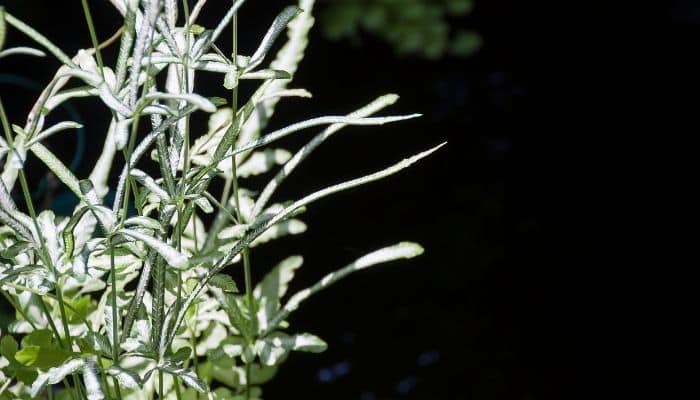
Is Silver Lace Fern an Indoor Plant?
Silver lace ferns are typically grown indoors or in greenhouses to maintain their native humid climate since they don’t tolerate the cold well.
They can be grown outdoors in suitably humid climates with filtered light conditions, such as plant shelters that provide frost protection.
Is Silver Lace Fern the Same as Silver Fern?
No, silver ferns are medium-sized evergreen tree ferns that are endemic to New Zealand and reach heights of 32 feet.
Unlike the wider leaf shape and variegation of silver lace ferns, silver ferns feature long lance-shaped fronds that have a uniform dark green color with gray undersides.
Is Silver Lace Fern the Same as Lace Fern?
No, the fronds of lace ferns have a fluffier texture and a denser form compared with silver lace ferns.
As their name suggests, the prominent feature of their shamrock-green fronds is a very fine structure that appears almost laced with thread compared with the wider, detailed leaves of silver lace ferns.
Are Silver Lace Ferns Messy?
Silver lace ferns may shed their leaves in less-than-ideal living conditions such as overwatering and overexposure to direct sunlight.
But as evergreen ferns, this plant will naturally lose some leaves as winter ends to make room for new growth in the spring.
Prune back dying fronds as you spot them to control the mess of shedding foliage.
Should You Mist a Silver Lace Fern?
As high-humidity plants, regular misting (preferably daily) will benefit your silver lace fern.
Master Gardener and plant author of Houseplants for a Healthy Home Jon VanZile advises misting:
“as often as practical, preferably in the morning to prevent fronds from turning brown. Train family members to mist it whenever they pass by!”
What Does Epsom Salt Do for Ferns?
Epsom salt contains magnesium and sulfur, which aid plant growth and enhance green color.
An epsom salt treatment won’t be necessary if you are growing your silver lace fern under ideal conditions, but you can mix a ratio of 1 tablespoon of salt per gallon in your watering solution once monthly from spring to early fall.
Do Ferns Like Coffee Grounds?
Fern plants perform well in slightly pH acidic soil, so a 1/4 inch layer of coffee grounds makes a great addition when evenly distributed among organic bark and fibers.
Agriculturist Arifur Rahman of the Garden For Indoor blog also advocates using grounds as organic fertilizer due to the “gentle boost of nutrients such as nitrogen, magnesium, and calcium.”
Why Does My Silver Lace Fern Have Dry, Crispy Leaves?
Fern leaves with dried crispy margins (often accompanied by slight browning) point to a lack of humidity in the environment.
You should try misting more frequently to prevent this occurring on other fronds and amp up humidity levels with the help of a humidifier or pebble water tray.
Why Is My Silver Lace Fern Drooping?
Drooping fronds may indicate your silver lace fern has been under or overwatered.
If the drooping foliage is accompanied by yellowing leaves, this can mean the soil isn’t draining well enough and the roots are too soggy to take in nutrients.
It may need repotting in this case.
What Does an Overwatered Fern Look Like?
An overwatered fern will normally exhibit wilting, drooping leaves with vast areas of the foliage turning yellow if the soil has been sitting in water for long periods.
Always ensure the top few inches of soil dries out in between being watered. By checking every day in the beginning, you’ll gradually learn to predict a fern plant’s watering needs.
Why Does My Silver Lace Fern Turn Yellow?
Yellowing fronds on fern plants normally indicate overwatering, and the same can be true of silver lace ferns.
These plants may also turn yellow if humidity levels are too low, which is why using a humidifier or keeping the plant in a terrarium helps maintain a tropical microclimate.
Do Silver Lace Ferns Die Back in Winter?
Evergreen ferns such as silver lace ferns partially “die back” as temperatures drop in the winter, losing some of their foliage to accommodate the growth of new fronds in the spring.
Deciduous ferns meanwhile shed their foliage annually and will die back fully in winter before springing back to life as milder temperatures return.
3 Key Tips for Success With Silver Lace Fern
1. Cater to Their Sunlight Needs Throughout the Year
Ferns have survived for thousands of years on Earth, but they’d be doomed without the right light conditions!
If you can’t provide enough natural light indoors, give your silver lace fern the best chance by utilizing artificial LED grow lights to bring the sun to shady spots.
2. Get to Know their Preferred Watering Routine & Make It Stick
One of the best things you can do for your silver lace fern is to remember this: these plants are happiest in consistently moist soil.
Preventing the soil from extremes either way (soggy or bone dry) will take some trial and error, but checking on the soil daily will give you a good idea of when and when not to water.
3. Do All You Can to Sustain their Tropical Climate
Treating it to a daily morning mist, keeping it in a suitably steamy environment like your bathroom, and protecting it from nasty surprises such as temperature drops and spikes are all great ways to make your silver lace fern feel at home.
Conclusion
In summary, silver lace ferns lend an elegant decorative touch to any home, but they will only thrive when their humidity, sunlight, and soil conditions are ideal.
However, you display them, whether terrariums or stand-alone pots, ensure this versatile plant gets the care it needs to withstand pests and fungal disease and help it live a long, happy life.
Only logged in customers who have purchased this product may leave a review.

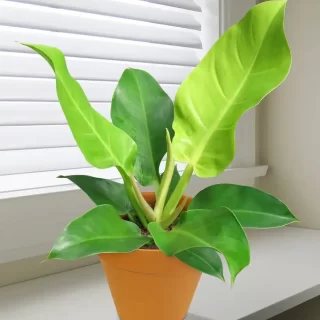
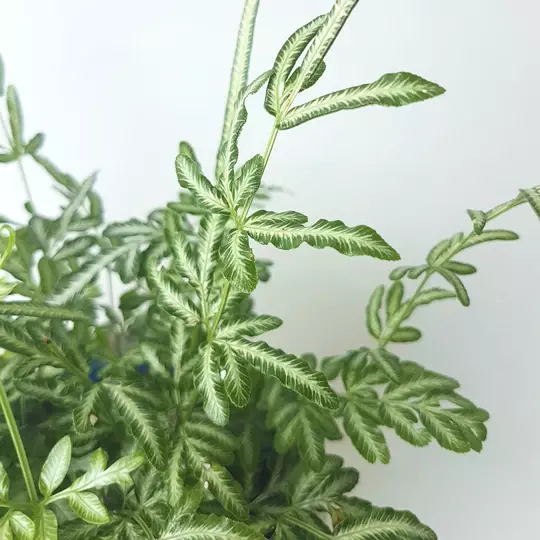



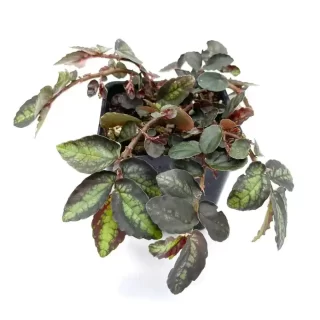
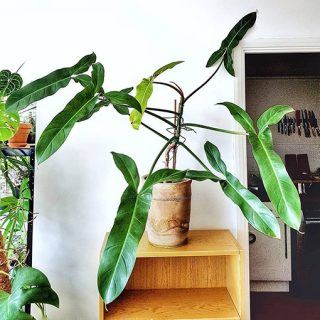
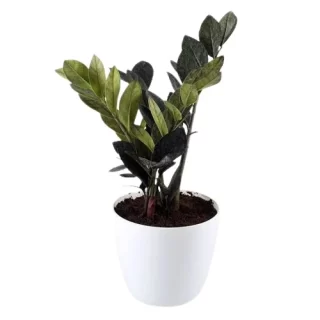
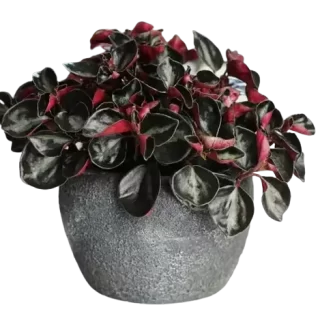

 If you need any assistance, I'm always here. Have you found what you were looking for?
If you need any assistance, I'm always here. Have you found what you were looking for?
Reviews
There are no reviews yet.